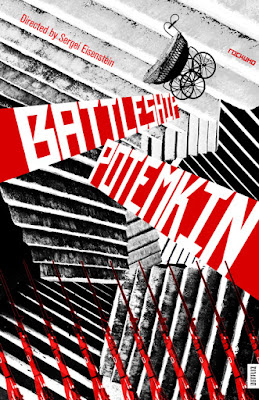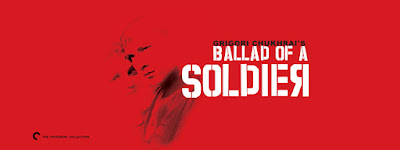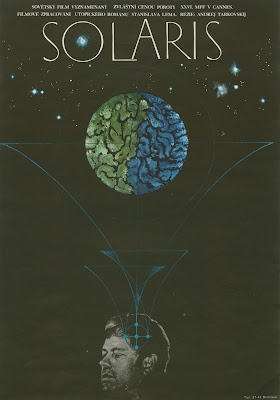Cinema of the Revolution
The 1917 Russian Revolution saw the overthrow of the tsar and his imperial form of government. The nation was radically re-organized along communist ideals. Energetic and passionate Soviet filmmakers like Sergei Eisenstein and Alexandr Dovzhenko in the 1920s made groundbreaking films that made use of new techniques like the montage to tell stories of the new revolutionary Soviet society. Though these films may be considered "propaganda" due to their overtly political messages, they are still masterpieces of world cinema, and offer a fascinating insight into the hopes and dreams of the Soviet Union just after the Revolution.
1.) Battleship Potemkin directed by Sergei Eisenstein (1925). Considered by many to be one of the greatest films ever made, Eisenstein's Battleship Potemkin tells the story of Russian navymen who rebel against their tsarist superior officers and take over their ship. Using non-professional actors, Eisenstein's film celebrates the solidarity of ordinary people who rise up against those who exploit them. His montage techniques create a unique and intense viewing experience, especially in the famous scene on the steps of the Odessa theater, in which tsarist troops brutally suppress a people's uprising as a baby carriage disturbingly bounces down the steps.
2.) Earth directed by Aleksandr Dovzhenko (1930). Like Battleship Potemkin, this film also celebrates the communist ideals of the Soviet Union. Instead of focusing on soldiers, however, Earth focuses on farmers, and offers a powerful ode to communist collective farms. The film harshly criticizes private property (and rich landowners), and celebrates the young hero Basil, a farmer who, while driving a tractor, inspires other poor farmers to take back the land and form a collective farm. Director Dovzhenko, like Eisenstein, uses the signature Soviet montage technique to intersperse lots of human faces, and the work they are doing. Again, this can be considered a propaganda film, but it is still bursting with real human passion.
3.) The Man With a Movie Camera directed by Dziga Vertov (1929). The opening titles of this astonishingly creative film proclaim that it's an experiment in cinematic language. There is no plot or dialogue. Rather, it's an hour-long montage--an ode to ordinary city life. The film feels less political than Potemkin or Earth. What makes the film uniquely Soviet, however, is its emphasis on collective humanity, as opposed to individual heroes. Politics aside, Man With a Movie Camera is a joyous piece of art, using early special effects like stop-motion animation, slow-motion, and superimposed images to celebrate city life in Moscow, Kiev, and Odessa.
4.) Mother directed by Vsevolod Pudovkin (1926). Based on the famous novel by Maxim Gorky, the film is set around the 1905 Bolshevik Revolution, and examines the relationship between a revolutionary young man and his mother, who at first doesn't want her son to get involved, fearing for his safety. After her son is killed in a worker's uprising, the mother heroically picks up the flag of her son's fallen comrades and defies the advancing Tsarist troops. Like earth, this film portrays the inter-generational aspect of the Revolution.
5.) Bed and Sofa directed by Abram Room (1927). This is perhaps the first "feminist" film. One of the central aspects of the Russian Revolution was to do away with bourgeois (middle class) values, including patriarchy. The liberated Russian woman was to be equal to men. Bed and Sofa examines a young husband and wife living in Moscow after the Revolution. The husband treats his wife like property, which betrays the ideals of the Revolution. After an affair with another man, the wife ends up leaving the marriage--in defiance of old-fashioned bourgeois patriarchy. The film has a radically progressive message, especially considering it was made in 1926!
6.) Aelita, Queen of Mars directed by Yakov Protazanov (1924). Based on Alexei Tolstoy’s novel, the film is an astonishing example of early science fiction. It tells of a young man, Los, traveling to Mars in a rocket ship, where he leads a popular uprising against the ruling group of Elders, with the support of Queen Aelita who has fallen in love with him after watching him through a telescope. One of the earliest full-length films about space travel, the most notable part of the film remains its remarkable constructivist Martian sets and costumes. Their influence can be seen in a number of later films, including the Flash Gordon serials and Fritz Lang’s Metropolis and Woman in the Moon. While very popular at first, the film later fell out of favor with the Soviet government and was thus very difficult to see until after the Cold War.
7.) The Extraordinary Adventures of Mr. West in the Land of the Bolsheviks directed by Lev Kuleshov (1924). The first Soviet film that explicitly challenges American stereotypes about Soviet Russia, the film is a broad satire of American ignorance of the Soviet Union. The naive American, Mr. West, (a Harold Lloyd type), is a YMCA president who is planning a trip to the newly founded Soviet Union to spread the idea of the YMCA. His wife, Madge, is worried that Russia is full of savage Bolsheviks who wear primitive rags and fur, as depicted in American media. He takes along his cowboy friend Jeddie for protection and as a companion. After an ordeal with a band of thieves, Mr. West is actually saved by Bolshevik police. Mr. West then takes a sightseeing tour of Moscow where his former beliefs are challenged. He concludes that the American view of the Soviet Union is wrong, and telegraphs his wife, instructing her to hang a portrait of Lenin in his study.
Cinematic Restrictions Under Josef Stalin
By 1930, Josef Stalin had risen to full control of the country, and the free-wheeling experiments of 1920s cinema were reigned in and restricted. Under Stalin, there was heavy censorship of what kind of films could be made. Thus, the films of the Stalin era tended to follow a pretty tight Soviet formula, often explicitly praising Stalin.
8.) Chapaev directed by Georgi and Sergei Vasilyev (1934). Tells a story about Vasily Ivanovich Chapaev, (1887–1919), a Red Army commander who became a hero of the Russian Civil War. It was a hugely popular success.
9.) Alexander Nevsky directed by Sergei Eisenstein (1938). Depicts the attempted invasion of Novgorod in the 13th century by the Teutonic Knights of the Holy Roman Empire and their defeat by Prince Alexander, known popularly as Alexander Nevsky.(1220–1263). The film climaxes in the half-hour Battle of the Ice, propelled by composer Prokofiev's ominous, rousing, triumphant musical narrative, a sequence that has served as a model for epic movie battles ever since (e.g., Henry V, Spartacus, and The Empire Strikes Back). Eisenstein made Alexander Nevsky, during the Stalinist era, at a time of strained relations between the Soviet Union and Nazi Germany. The film contains elements of obvious allegory that reflect the political situation between the two countries at the time of production.
10.) Ivan the Terrible parts I and II directed by Sergei Eisenstein (1944-1958). It is a two-part historical epic film about Ivan IV of Russia (aka Ivan the Terrible). It was commissioned by Stalin, who admired and identified himself with Ivan. Part I was released in 1944 but Part II was not released until 1958, as it was banned on the order of Stalin, who became incensed over the unflattering depiction of the “hero” as paranoid and destructive. Like pretty much all Eisenstein’s films, Ivan the Terrible is beautifully shot. Nearly every frame is a masterpiece of composition.
After Stalin, the Thaw
After Stalin's death in 1953, things began to thaw a bit in terms of censorship, and more films were made which offered a more nuanced view of Russian history and society.
11.) The Cranes are Flying directed by Mikhail Kalatozishvili (1957). It powerfully depicts the cruelty of war and the damage suffered to the Soviet psyche as a result of World War II (known in the Soviet Union as the Great Patriotic War). It won the Palme d’Or at the 1958 Cannes Film Festival, the only Soviet film to win that award.
12.) Ballad of a Soldier directed by Grigori Chukhri (1959). While set during World War II (or, The Great Patriotic War), Ballad of a Soldier is not primarily a war film. It recounts, within the context of the turmoil of war, various kinds of love: the romantic love of a young couple, the committed love of a married couple, and a mother's love of her child, as a Red Army soldier tries to make it home during a leave, meeting several civilians on his way and falling in love. The film won several awards, including a BAFTA and was nominated for an Academy Award.
13.) Moscow Does Not Believe in Tears directed by Vladamir Menshov (1980). It tells the story of three women searching for love over a 20-year period between 1958-1978 in Moscow. Author Martha Nochimson writes, “The film affectionately shows each woman facing disappointment, and comically laughing at the things that go wrong in the “worker’s paradise” of Moscow…When, at the end of the film, one of the woman says to the man she loves, ‘Oh how long I’ve searched for you,’ she seems to be summing up the post-Stalinist sentiments of an entire nation.” It won the Academy Award for Best Foreign Language Film in 1980.
The Films of Andrei Tarkovsky
This past Spring, at the Hibbleon Gallery film series, my friend Steve Elkins curated a month of films by Andrei Tarkovsky, whose radically unique films explored the interior dreams and nightmares of people living in the Soviet Union. Steve wrote, "Few people have been cited as "greatest filmmaker of all time" more often than Russian director Andrei Tarkovsky (1932 - 1986), whose cinema sought to explore the metaphysical crashing through the surface of everyday life. Unlike the "utopian" films of the earlier Soviet era, many of Tarkovsky's films may be considered "dystopian," exploring individuals struggling against crushingly difficult circumstances. Here are the films we showed, along with Steve's description of them...
14.) "IVAN'S CHILDHOOD" (1962), exploring childrens' relationship to dreams, and their developing awareness that there is something just beneath the skin of the world that one might describe as spiritual.
15.) "ANDREI RUBLEV" (1966). Few films have more commonly been hailed as "Greatest Film Ever Made" than "ANDREI RUBLEV" (1966), based on the true story of a man who devoted himself to painting icons while medieval Russia and its collective faith in God was crumbling under the Tatar invasion. Exploring the Orthodox belief that art is an expression of the Incarnation, whereby matter becomes "spirit-bearing," ANDREI RUBLEV is a profoundly moving testament to art as a vehicle of resurrection within ourselves, and of communion with our neighbors; an act of love in which true affirmation of the self is found in sacrifice.
16.) "SOLARIS" (1972). The Soviet response to Stanley Kubrick's "2001: A Space Odyssey," in which director Andrei Tarkovsky discards all the politics and ideologies of the Cold War space race to explore the cosmos as a living and possibly conscious organism of which the human brain is an organ, as was believed by the father of Soviet aeronautics Konstantin Tsiolkovsky. Envisioning space as an inverted mirror, in which what seems to be a journey outward is in fact a journey inward, "Solaris" attempts to grasp whether all the celebrated advances of the space program are a "worn-out old bus" compared to the technology of tears and memory, those small miracles through which we face and grapple with the Ineffable.
17.) "MIRROR" (1974). One of Tarkovsky's most radically experimental works, and nearly impossible to describe, "MIRROR" was Tarkovsky's next major step in developing a cinema reflecting his belief that "poetic reasoning is closer to the laws by which thought develops, and thus to life itself, than is the logic of traditional drama...Through poetic connections, the spectator becomes a participant in the process of discovering life, unsupported by ready-made deductions from the plot or ineluctable pointers by the author...In a word, the image is not a certain meaning, expressed by the director, but an entire world reflected as in a drop of water...I am interested in man, for he contains a universe within himself; and in order to find expression for the idea, for the meaning of human life, there is no need to spread behind it, as it were, a canvas crowded with happenings."
18.) "STALKER" (1979). A "Stalker" is a guide who leads people through a region in which the normal laws of reality no longer fully apply, known as The Zone. The Zone contains a place called the "Room." A writer and a scientist place their fate in the hands of a Stalker to take them there. Widely regarded as one of the great masterpieces of world cinema, the film was shot primarily near toxic sites in Estonia that soon led to the deaths of nearly everyone involved in the film, including Tarkovsky himself.
19.) "NOSTALGHIA" (1983). Two people traveling across the ravishing beauty of Tuscany to find Renaissance paintings of the Madonna del Parto by Piero della Francesca (shot while Tarkovsky was literally on the run from the KGB), becomes the springboard for an in-depth meditation on the human desire to return to the source of all life, to our mothers, to reintegrate the fragments of ourselves that are scattered around the globe in the form of various cultures; in short, the spiritual crisis that occurs when one cannot unite the world within oneself.
20.) "The Sacrifice" (1986) The Sacrifice (Swedish: Offret) is a 1986 Swedish film directed by Andrei Tarkovsky. Starring Erland Josephson, it centers on a middle-aged intellectual who attempts to bargain with God to stop an impending nuclear holocaust. The Sacrifice was Tarkovsky's third film as a Soviet expatriate, after Nostalghia and the documentary Voyage in Time, and was also his last, as he died shortly after its completion. Like 1972's Solaris, it won the Grand Prix at the Cannes Film Festival.
Post-Soviet Cinema
For this section on Post-Soviet Cinema, I will rely on descriptions by the author of our textbook World on Film, Martha Nochimson…“With the official fall of the Soviet Union in 1991, Russian film reemerged for the first time since 1917, and it immediately shed all suggestion that individuals were only waiting to be fused with one another in perfect Communist solidarity. In its depiction of the lives of people lost in the modern world, and confused about how they relate to others and to their country, post-Soviet, or Russian cinema, liberated from easy utopian answers, began to struggle with the definition of what it meant to be a human and with questions about the definition of a just society.” (Martha Nochimson, World on Film)
21.) Three Stories directed by Kira Muratova (1997). From a maverick post-Soviet filmmaker exploring dystopia, as opposed to utopia, this film juxtaposes three vignettes of toxic contemporary life.
22.) Taxi Blues directed by Pavel Lungin (1990). A dark comedy “which explores the gains and losses involved in the impending fall of the Soviet Union. In it, Shlykov, an old taxi driver who misses the ‘good old Communist days’ tries in vain to feed a generous helping of old Soviet values to Lioshy, a young jazz musician.”
23.) Burnt by the Sun directed by Nikita Mikhalkov (1994). “Tells the story of the Stalinist purge of General Sergei Petrovich Khotov, a hero of the Russian Revolution, who was executed on trumped-up charges because Stalin felt that Kotov was a threat to his total political control…a true post-Soviet film which reveals formerly forbidden, painful truths about Stalin’s Russia. Burnt by the Sun won the Academy Award for Best Foreign Language Film in 1995.
24.) Moloch directed by Aleksandr Sokurov (1999). A disciple of Andrei Tarkovsky, Sokurov, like his mentor, used long takes to create internal, meditative films. Moloch is part of Sorurov’s “Tetrology of Power” a four-film series that focuses on the psychology of power through the lens of real and fictional characters like Adolf Hitler, Japanese Emperor Hirohito, and Faust. Moloch focuses on Hitler’s “carefree” weekend in a country castle, and totally subverts Hitler’s flawed ideology and psyche. In some ways, the film can be seen as a counterpoint to the Nazi propaganda film Triumph of the Will.
25.) Russian Ark directed by Aleksandr Sokurov (2004). A 99-minute film about Russian history made completely without editing in ONE TAKE! Showing Russian history as an elaborate and festive ball that flows through time, Sokurov subverts the ideological view of history that was central to Communist dogma by resurrecting Russian nobility from past centuries that were supposed to have been superseded by the government of the workers. This movie is totally unique and beautiful, and it was shot in the gorgeous Hermitage museum in St. Petersburg.
This list is, of course, incomplete, and meant only as an introduction to the cinema of Russia. Stay tuned for next week's post...An Introduction to German Cinema!
























